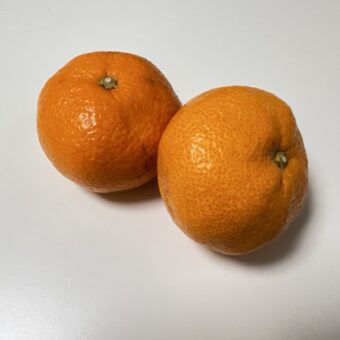About Japan, To Eat and Drink
Mikkabi Mikan tangerines
If you have visited Japan during the winter season, one of the fruits you will have eaten is the tangerines. Japanese tangerines are very different from those in other countries, both in shape and taste. Outside Japan, they are sold in supermarkets under the trade name “Satsuma”, but they are smaller than the tangerines you eat in Japan.
Japanese tangerines are smaller than Valencia and California oranges, but larger than Satsumas, and are slightly flattened rather than spherical in shape. The skin is soft and can be easily peeled without a knife, and the juice does not overflow when peeled. Each cluster of fruit is independent and is eaten by removing a small piece of the white fibre from the cluster. Most Japanese tangerines on the market do not have seeds.
There are several famous tangerine production areas in Japan, and they vary in size, sweetness and acidity, but the one I like best is the Mikkabi Mikan(三ヶ日みかん) brand.
Mikkabi Mikan is one of the varieties of tangerines grown in Shizuoka Prefecture, Japan, and takes its name from the Mikkabi area. Mikkabi is a city known for the discovery of fossil human bones from the Jomon period (5,000-4,000 years ago) and is located north-west of Lake Hamana, which is famous for its eel farming.
Mikkabi Mikan are large, thin-skinned, well-fruited and very easy to eat, with few white fibres attached to the fruit bunches. It is also characterised by its high juice content and sweetness. They are shipped all over the country, but the price is a little high because they are so delicious that once you have tasted them, you will never forget them.

The reason why I like Mikkabi Mikan is, of course, because of the taste, but also because I have good, nostalgic memories of these tangerines.
When I was much younger than I am now, I had a senior colleague from Shizuoka Prefecture at the company I worked for, and every year around Christmas time, her family would send the company a large gift of Mikkabi Mikan as a year-end present. That was how I came to know about Mikkabi Mikan. It was a luxury to be able to eat so many of these tangerines every year. But it was an annual event for me at the time, so I didn’t think it was anything special. Some time after I left the company, I found some Mikkabi Mikan at a fruit shop and wanted to buy them, but they were much more expensive than the tangerines I usually bought, so I remember giving up. That was the first time I became aware that Mikkabi Mikan was a “brand name”.
Sometimes I get excited and buy Mikkabi Mikan, and every time I do, I remember when I was working in a company and all the employees used to eat Mikkabi Mikan every day as a dessert for lunch.
*The market price of Mikkabi Mikan is approximately JPY700/kg.
